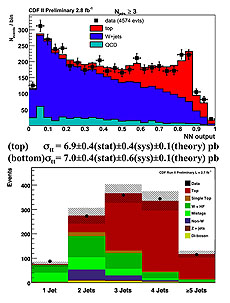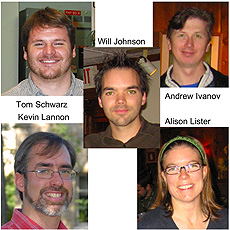On top of Zs CDF gains

Top figure: A neural network distribution is used to extract the top pair production cross section for one of the analyses. The signal peaks on the right whereas the background peaks on the left. Bottom figure: This figure shows the distribution of the number of jets in the analysis that involve b-jet identification.
By making judicious use of Z bosons, scientists at CDF are able to dramatically reduce the uncertainty of the top quark pair production cross section. By comparing the number of identified top quarks to the number of identified Z bosons, CDF scientists have effectively increased the data sample from 2.8 inverse femtobarns to 10 inverse femtobarns. Thus, the measured top cross section is now known at the same level of accuracy as the theoretically calculated one.
The Z cross section is very well known both experimentally and theoretically, so it provides an excellent standard when compared to any other cross section.
How does the ratio, or the comparison of Z bosons to quarks, achieve such remarkable results? By using the ratio, CDF physicists can all but cancel out the uncertainty from the luminosity measurement. Scientists measuring the number of particle collisions, or luminosity, always have a degree of uncertainty associated with this measurement. In this case, that amount of uncertainty is the highest source of uncertainty relating to the individual cross section measurements. The uncertainty due to the luminosity does not decrease as scientists accumulate more statistics. Rather, this uncertainty is dominated by the theoretical knowledge of the total rate of proton-antiproton collisions and by the intrinsic uncertainty of the detectors used to measure it.
Physicists applied this comparison technique to two separate top cross section measurements. One analysis requires the identification of b-quarks from the top decay. A second analysis relies on the observed particle properties of the events. The second analysis has the advantage of including more signal events; over 1,000 reconstructed top quark pair candidates. However, the trade off is that the backgrounds that mimic a top signal are also larger. To deal with these large backgrounds, scientists use an artificial neural network. This acts like a human brain, examining many elements simultaneously. In both of the analyses, the CDF scientists saw the total uncertainties decrease by over 10 percent.
With the Tevatron performing so well, studying top quark pair production is truly becoming precision physics. Analysis tricks such as these ratios are key to further scrutiny of Standard Model physics, in search of signs of something unexpected!
More information on these analyses can be found here or here.

Andrew Ivanov, Will Johnson, Alison Lister and Tom Schwarz, UC Davis; Kevin Lannon, University of Notre Dame. Not pictured: Robin Erbacher and John Conway,UC Davis; Richard Hughes and Brian Winer, Ohio State University.
|